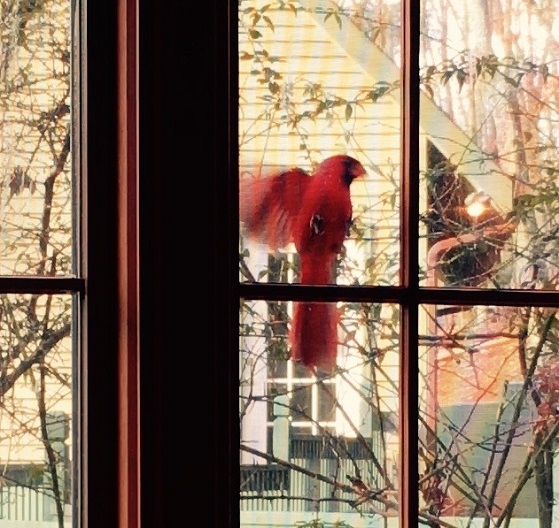Angry Birds: 5 Reasons To Let It Go.
It was a cloudy, brisk winter day in the Appalachian Mountains. My coffee was hot, steam rising from my cup, and I was ready to chug ahead on an article I was writing.
Just a few minutes into my brainstorm and brew, my attention was drawn to a soft knock. I tried to ignore it, but the insistent sound drilled into my brain, repeating every 10 seconds. Curiosity roused, I tiptoed around the house to investigate. Eventually, through the living room window, I spotted him.
A beautiful red bird was perched in a tree a few feet away. He was charging the living room window repeatedly like a belligerent kamikaze pilot — feet first, wings outstretched.
My stomach dropped as I was reminded of the yellow finch, whose little body mysteriously showed up on my porch a couple of years ago. At the time, after burying the little guy, I did some research and learned that certain territorial birds become obsessed with windows.
Inflamed with threat, they attack their own reflection, certain it is an intruder. I intended to write about it at the time, but didn’t, and now nature had come knocking again, reminding me of a lesson we all struggle to learn.
I tried my best to scare the red bird away. I yelled. I clapped. I moved the curtains, attempting to startle him with the fluttering patterns of the fabric. I even tried taping a picture of a politician who was grabbing the headlines in the spot he was aiming at. Wouldn’t that scare away anyone? Nope. Apparently not.
I tried to send the bird telepathic images as I was taught in an animal communication class some years ago. I even resorted to playing soothing music at the site of the glassy battlefield to calm him. Nothing worked. In the end, I had to let it go.
But I used that moment and the sacrifice of that poor, belligerent bird as the metaphor nature may have intended. A metaphor that reminds us all of the toxicity of holding on to anger and all the reasons we need to let it go.
1. Anger is like a boomerang.
We often delude ourselves into thinking anger is only directed outwards, towards a specific person. We can become trapped in our belief that we are separate. We perpetuate the denial that we are all interconnected, in a vast web of energy and relationships.
When we put our anger out into the world, sooner or later, it vibrates along those threads of connection and journeys back to us.
2. Anger isn’t productive.
There is a time to accept limitation. Instead of angrily slamming into the walls in front of us, we can learn to investigate and understand them. The Dalai Lama, Mahatma Gandhi, MLK Jr. and Nelson Mandela took their righteous anger and transmuted it.
They found peace despite unbearable unfairness directed at them, and charted poetic, productive courses, energized by injustices that could have easily eaten away at them. Peaceful persistence prevails.
3. Anger is reactive rather than creative.
Anger is often driven by a determination to prove something or diminish someone else, in order to receive satisfaction in the face of perceived injustice. This approach isn’t likely to provide fulfillment, and furthermore, it places you in a space of being reactive rather than creative.
4. Anger is toxic.
We can become inflamed until death. Anger causes inflammatory biological responses in the body. Think heated battle. While inflammation is helpful in fighting infection, most of the inflammation we experience is induced by our emotions. When chronic, it is damaging to our tissues.
One way your body may be trying to communicate with you about unresolved anger issues is if you have heart or liver issues. Anger hides out and imbalances the energies in these vital organs. A tendency toward alcoholism, poor diet and road rage are also clues that anger is harming you from within.
5. Anger is a lesson.
Sometimes you won’t be able to help another break through an anger trance.
I tried to startle the bird away, communicate with him, and use compassion. Nothing seemed to work. He was determined. It is painful to watch someone we love be consumed by anger. It’s hard to observe loved ones hitting the wall or going back for another round of a painful lesson. After all, the outcome is predictable.
It’s sad to see talent and beauty be wasted. Being a loving observer is difficult, and it’s okay to have boundaries, step away and take a break when you need to. We must remember, it is their lesson to learn, and our attachment to the timing of their learning often just adds to the resistance and becomes a distraction.
What lessons have you learned about anger? I’d love to hear more about your journey towards healing in the comments below.
***
{Join us on Facebook, Twitter & Instagram}

